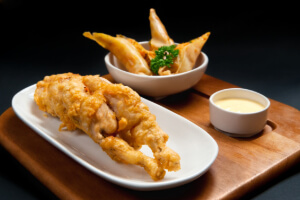
One dish above all else exists that is uniquely and almost always associated with French cuisine that stands out. It isn't the famous baguettes or cheeses, but frog legs. For the French, they have been eating frog legs, or cuisses de Grenouille, for many years and it is a beloved appetizer or main meal.
However, the French were hardly the first to incorporate frog legs as part of a meal. Historical records show that the frog's legs were a common food in southern China as early as the first century A.D, and the Aztecs, too, were fond of consuming them for food. In Roman history or European accounts, the mention of frog's legs does not arrive until roughly the 12th century when they appear in the histories of the French Catholic church.
Today, frog legs are still considered part of the world's cuisine outside of France, including Vietnam, Cambodia, Thailand, Indonesia, Northern Italy, the Alentejo region of Portugal, Spain, Albania, Slovenia, Romania, Bulgaria, Northwestern Greece and here in the Southern United States.
And while eating frog legs is still associated more commonly in the United States and Europe with the French, bone fragments dated to nearly 10,000 years ago that had been cooked in some manner were discovered at an ancient site in Wiltshire, England, not far from Stonehenge, long before the first official documentation of the French ever eating the frog.
Popular Legend
One of the most popular legends involving frog's legs in the past tells us of authorities within the church ordering French monks, whom they felt was growing too plump, to adopt a meatless diet. Yet, these hungry monks had a clever idea and found a loophole that allowed amphibians, like frogs, to be counted as fish and their feasting supposedly continued. It is then claimed that the local peasants soon followed the monk's example and began adding frogs to their original diet.
The exact time and the reason as to when humanity began consuming frog legs are murky and unclear at best, but it should not be a surprise that our hunter-gatherer ancestors would have eaten small animals like frogs and toads. They were extremely useful and no doubt a plentiful source of protein and relatively easy as well as fast to cook.
So how did such humble and simple beginnings end up on some of the most refined restaurant menus throughout the eras?
18th Century Haute Cuisine
Cookbook recipes dating back to the 18th century indicate that frog legs were a part of haute cuisine ('high cooking') but there is a difficult trail of information to follow as to understanding how they got there in the first place. Before the 18th century, few if any cookbooks exist detailing how to cook food or what the masses might have eaten.
And while the oldest known evidence shows that frog legs were consumed both in China and England, many food historians are puzzled by England's reputation for not liking frog at all. The English do tend to perceive frog as being French cuisine yet remain repelled by the idea of consuming it themselves. Perhaps it is due to how frogs appear, or the misinformed thought that they are some sort of smelly, slimy creature that exists in even fouler smelling ponds and swamps.
Why Just the legs?
It is the legs which are the only edible part of the frog and also, the meatiest. For the frog legs to be consumed properly, they need to be skinned, soaked in cold water, saltwater, or a milk bath before being cooked as well. The soaking step seems controversial for several cooks from professional to home level, owing to the reason as there is no clear explanation other than, 'it has always been done,' (although several cooks and chefs alike swear that by soaking, you reduce the wild, gamey flavor of the frog meat).
Another reason why you would eat only the legs because the rest of the frog is innards, rib cage, intestines, and other viscera that simply isn't good to consume while the legs are meat and bone.
How Popular are Frogs' Legs Still?
According to a government figure, the French still consume roughly 70 tons a year of domestically gathered legs each year and shipping in as much as 4,000 tons annually since 1995. Besides frog festivals in France, such as the popular Foire aux Grenouilles, frogs' legs are still one of the most sought after and distinctly French delicacy found in some of the most respected and exclusive restaurants.
Belgium and Luxembourg are also frog legs consumers, but it is the U.S. frogs' legs consumption of this unusually savory dish that comes in closest to France.
Brought to the United States by the former French Colony of Louisiana, today, the city of Rayne likes to call itself Frog Capital of the world with a surprising amount of frog legs being eaten by both Arkansas as well as Texas.
Should You Try Frog legs?
Absolutely! Not only are frog legs rich in protein, but frog leg meat is also delicate with a savory hint of fish that beautifully absorbs and enhances the flavor of any meals, spices, rubs, or coating that you may cook them.
To ensure that we are protecting the environment, all of our frog meat is ethically sourced from a frog farm. This also means our frogs' legs are more flavorful, less gamey, and often much larger than the wild-caught frogs you may see elsewhere!

